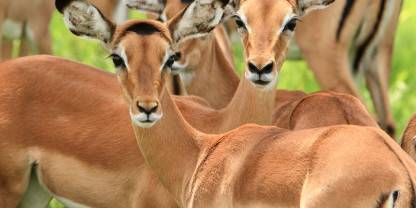Average Expert Rating
Rating Breakdown
Write a User ReviewConservation and Traditions in Eswatini
Eswatini (formerly Swaziland) is a tiny, landlocked monarchy almost entirely surrounded by South Africa, with only its northeastern corner touching Mozambique. Border formalities are pleasantly relaxed, and because the kingdom lies conveniently on the main overland route between Kruger National Park and KwaZulu-Natal, most visitors pass through as part of a South African holiday. Yet, while it’s easy to simply drive straight across the country, Eswatini rewards those who linger with far more to see and experience than first impressions suggest.
By the late 1950s, Eswatini was largely depleted of wildlife, but the turnaround since then has been remarkable, thanks primarily to the tireless efforts of conservation pioneer Ted Reilly. Today, several small but rewarding reserves fall under the Big Game Parks organisation. Mlilwane Wildlife Sanctuary, free of dangerous predators (aside from crocodiles), is perfect for unguided walking, horse riding and mountain biking. For a more
While the Big Game Parks reserves offer reasonable wildlife viewing, they can feel slightly tamed. Malolotja Nature Reserve, by contrast, is wonderfully wild and pristine. Its dramatic mountain landscapes make it a top destination for hikers, whether you’re after an easy day walk or a demanding multiday trek.
The Malolotja Canopy Tour offers a different perspective on the reserve’s incredible topography. This thrilling ziplining adventure that sends you soaring above forested gorges and cascading streams, with sweeping views of the reserve’s rugged mountains, was one of the highlights of my last visit. Other adventure activities on offer in Eswatini are rafting, caving, abseiling and canoeing.
Despite its small size, what truly distinguishes Eswatini is a strong sense of tradition. To appreciate this, slow down: browse colourful markets, chat with locals and pick up some crafts. For a deeper cultural experience, try to time your visit with one of the kingdom’s vibrant annual festivals, the best known being the Umhlanga (Reed Dance) in August or September.
By the late 1950s, Eswatini was largely depleted of wildlife, but the turnaround since then has been remarkable, thanks primarily to the tireless efforts of conservation pioneer Ted Reilly. Today, several small but rewarding reserves fall under the Big Game Parks organisation. Mlilwane Wildlife Sanctuary, free of dangerous predators (aside from crocodiles), is perfect for unguided walking, horse riding and mountain biking. For a more
Read more
traditional safari, Hlane Royal National Park and Mkhaya Game Reserve offer better game-viewing experiences. Hlane provides simple, family-friendly accommodation and excellent rhino sightings, while Mkhaya offers a more exclusive experience with a luxury lodge and guided drives and walks. Both reserves are strongholds for rhinos, and approaching these giants on foot is a genuine highlight. Elephants, giraffes and a good mix of antelope species are easily seen, and Hlane has lions – though they are kept in a separate enclosure.While the Big Game Parks reserves offer reasonable wildlife viewing, they can feel slightly tamed. Malolotja Nature Reserve, by contrast, is wonderfully wild and pristine. Its dramatic mountain landscapes make it a top destination for hikers, whether you’re after an easy day walk or a demanding multiday trek.
The Malolotja Canopy Tour offers a different perspective on the reserve’s incredible topography. This thrilling ziplining adventure that sends you soaring above forested gorges and cascading streams, with sweeping views of the reserve’s rugged mountains, was one of the highlights of my last visit. Other adventure activities on offer in Eswatini are rafting, caving, abseiling and canoeing.
Despite its small size, what truly distinguishes Eswatini is a strong sense of tradition. To appreciate this, slow down: browse colourful markets, chat with locals and pick up some crafts. For a deeper cultural experience, try to time your visit with one of the kingdom’s vibrant annual festivals, the best known being the Umhlanga (Reed Dance) in August or September.
A scenic country of emerald peaks, valleys and waterfalls and easy wildlife reserves to visit
Covering just over 17,000-sq-km (smaller than Kruger National Park), Eswatini is the smallest country in the southern hemisphere, and Africa’s last absolute monarchy. King Mswati III recently renamed Swaziland the Kingdom of Eswatini (‘place of the Swazi’) to mark 50 years of independence from British rule. It’s so little, I’ve driven across in less than a leisurely day, but there are plenty of things to do to keep you busy on a longer visit, from hiking in lush mountain landscapes to game-viewing in the parks and reserves. It’s also a good destination for adventurers, with an effective backpackers’ set-up and a number of activities on offer from caving to white-water rafting. The Swazi people are expert craft-makers, producing a wealth of high-quality African curios like pottery, baskets, traditional fabrics, soapstone carvings and beaded jewellery, and there are plenty of souvenir centres and shops to visit too.
Thanks to a handful of pioneering conservationists,
Thanks to a handful of pioneering conservationists,

